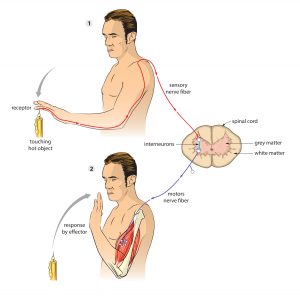An Understanding of Spasticity requires an explanation of how increased muscle tone arises:
- Maintaining posture requires spinal reflex pathways which correct limb position in response to pressure changes in weight bearing areas; position changes in joints or stretch in muscles.
- The balance that is created in response to these reflexes leads to normal postural tone.
- Normal reflex pathways are modified or overridden by higher pathways directed at:
- Conscious initiation of movement (Cerebral initiation).
- Coordination of intended movement or position (cerebellar and extrapyramidal pathways).
- Unless overridden or modified, there is a mismatch in inhibitory / excitatory modification of reflex pathways, which leads to restriction of active movement.
If an upper motor neurone injury occurs, the ability to modify reflex pathways is lost. In this situation the reflex pathway remains intact and responsive however without modification it becomes overly responsive to muscle stretch. Spasticity, in effect, is the consequence of multiple spinal reflexes firing in an unmodified pattern.
Muscle/Tendon Shortening
There are two factors which lead to resistance to passive movement following Upper Motor Neuron injury:
- The neurogenic component – spasticity as described above.
- The biomechanical component – stiffening & shortening of the muscle and other tissues after a period of disuse or limited use. This is sometimes referred to as contracture.
The likelihood of this muscle or tendon shortening occurring is proportional to the duration of time for which spasticity is present.
One of the goals in treating spasticity is to reduce the likelihood of muscle shortening occurring. If muscle or tendon shortening occurs, it is very difficult to reverse other than by complicated surgical interventions.

